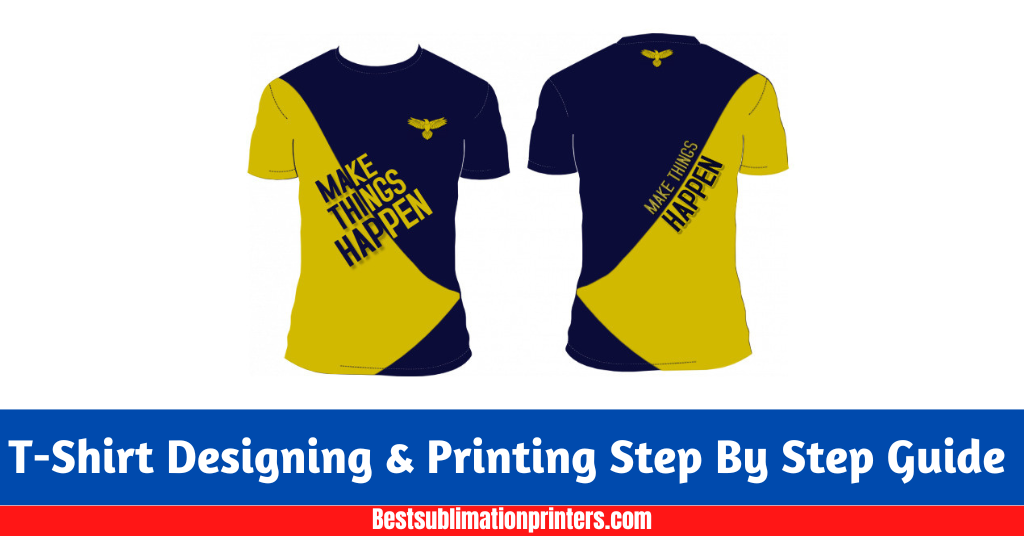T-shirt designing and printing is the process of creating and producing customized t-shirts with a specific design or message. It is a popular way for individuals and businesses to express themselves and promote their brand or message. T-shirt designing and printing involve several steps, including choosing a design concept, sketching out the design, refining the design, choosing a printing method, preparing the artwork, printing a test print, printing the final product, curing the ink, and performing quality control. There are various methods for printing t-shirts, including screen printing, direct-to-garment printing, and heat transfer. With the right tools and techniques, anyone can create high-quality custom t-shirts that are perfect for any occasion.
Steps of T-Shirt Designing and Printing
There are several steps involved in designing and printing a t-shirt:
Choose a design concept
First, decide on the overall look and theme of the t-shirt. This may include the color scheme, imagery, text, and other elements you want to include.
Sketch out the design
Next, sketch the design on paper or use a digital drawing program to create a rough draft of the t-shirt design.
Refine the design
Once you have a rough draft, start refining the design and making any necessary changes. This may involve adjusting the layout, tweaking the color scheme, or adding or removing elements.
Choose a printing method
There are several different methods for printing t-shirts, including screen printing, direct-to-garment printing, and heat transfer. Choose the method that best fits your needs and budget.
Prepare the artwork
Once the design is complete, prepare the artwork for printing. This may involve creating separate layers for different colors, converting the file to a format compatible with the printing method, and ensuring all elements are properly aligned.
Print a test print
Before printing the final product, it’s a good idea to print a test print to ensure that the design looks as you intended and that there are no issues with the printing process.
Print the final product
Once satisfied with the test print, you can print the final product. This may involve setting up the printing equipment, preparing the t-shirts, and printing the design onto the t-shirts.
Cure the ink
Depending on your printing method, you may need to cure the ink by exposing it to heat or letting it sit for a certain amount of time. This helps to set the ink and ensure that it will not fade or crack over time.
Quality control
Finally, inspect the finished t-shirts to ensure they meet your quality standards. Make necessary adjustments or corrections, and then package and ship the t-shirts to your customers.
Materials Required For T shirts Designing and Printing
The following materials are required for t-shirt design and printing:
T-shirts:
The most obvious material required for t-shirt designing and printing is the t-shirts themselves. You will need to choose the size, style, and color of the t-shirts you will print.
Design software:
Depending on the method you use to design your t-shirts, you may need software such as Adobe Photoshop or Illustrator. These programs allow you to create and edit digital graphics and artwork.
Printing equipment:
The type of printing equipment you will need depends on your printing method. For example, screen printing requires a screen, ink, and a printing press, while direct-to-garment printing requires a specialized printer.
Ink:
You will need ink in the colors you want to print on your t-shirts. Various types of ink are available, including plastisol, water-based, and discharge, each with its own characteristics and best uses.
Transfer paper:
If you are using heat transfer to print your t-shirts, you will need transfer paper, which is used to transfer the design from the printer to the t-shirt.
Heat press:
A heat press is a machine that applies heat and pressure to transfer the design onto the t-shirt. It is an essential piece of equipment for heat transfer printing.
Other supplies:
Depending on your printing method, you may also need other supplies such as screens, emulsion, and stencils for screen printing or a heat transfer vinyl cutter for heat transfer printing. You may also need basic supplies such as gloves, masking tape, and a squeegee.
Conclusion
In a nutshell, t-shirt designing and printing is the process of creating and producing customized t-shirts with a specific design or message. It requires various materials, including t-shirts, design software, printing equipment, ink, and other supplies. With the right tools and techniques, anyone can create high-quality custom t-shirts that are perfect for any occasion.

